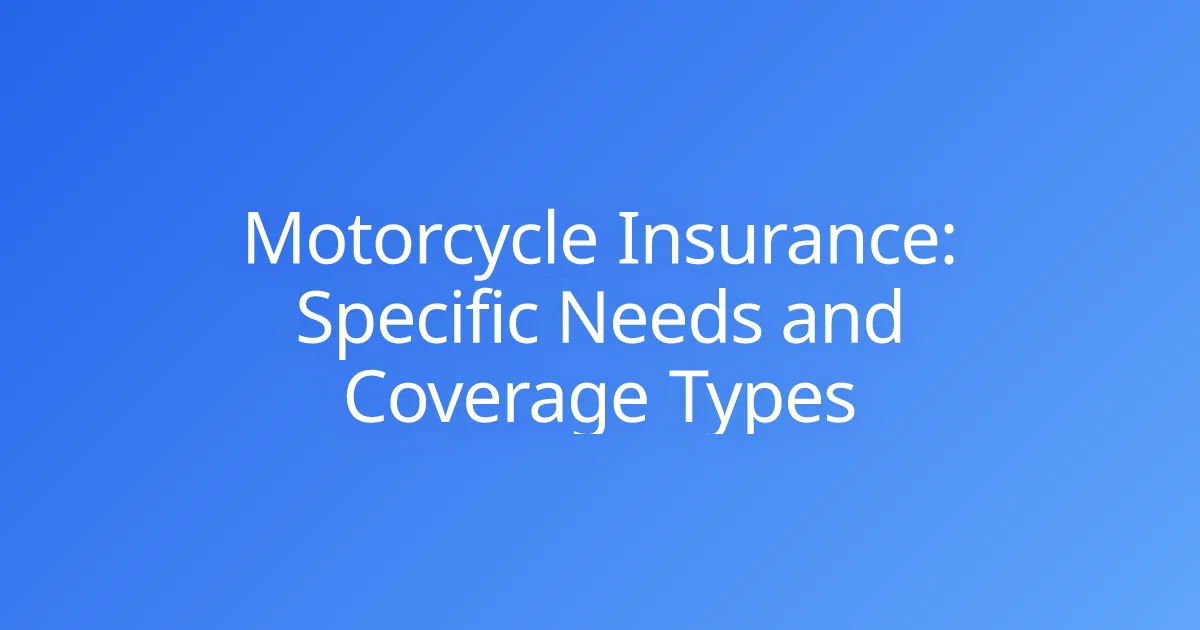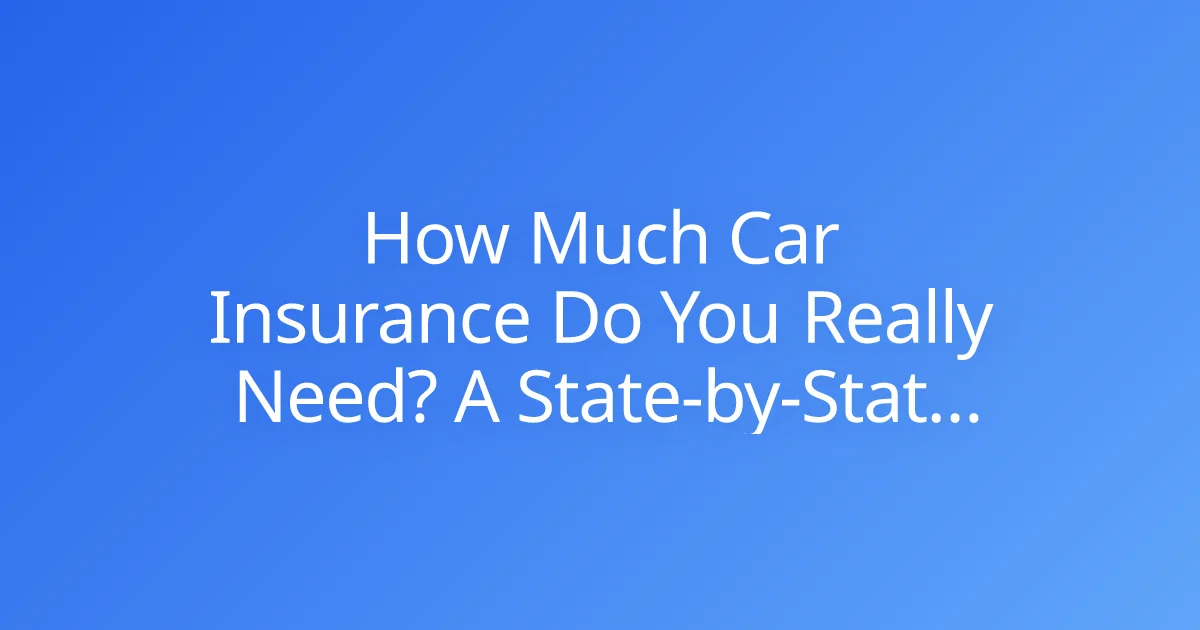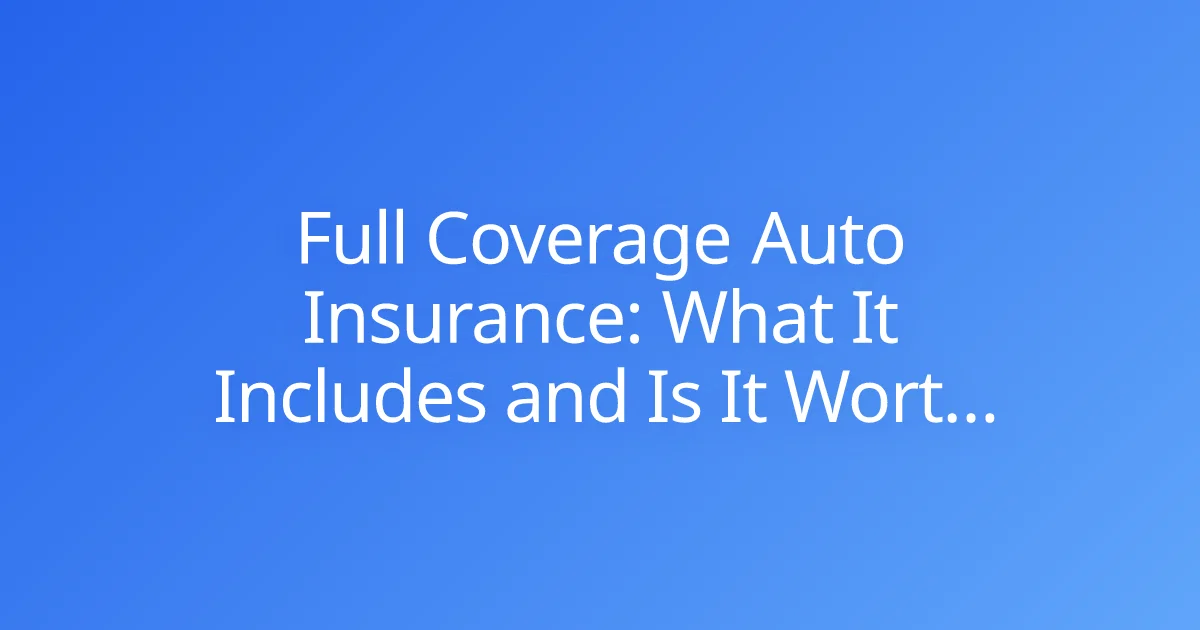Motorcycle Insurance: Specific Needs and Coverage Types
There's an unparalleled sense of freedom that comes with hitting the open road on a motorcycle, the wind in your face and the world at your fingertips. This exhilaration, however, comes with its own set of unique risks. Accidents, theft, and unforeseen damages are unfortunate realities, and while many riders understand the need for basic coverage, they often operate under the mistaken belief that their standard auto insurance policy offers sufficient protection. This critical oversight can leave riders vulnerable to devastating financial losses, legal liabilities, and the emotional toll of an unprotected journey.
At The Policy Explainer, we understand the passion for riding and the paramount importance of safeguarding that passion. This comprehensive guide will delve deep into Motorcycle Insurance, breaking down its specific needs and coverage types. We'll illuminate why your standard car insurance won't cut it, explain the essential protections tailored for two-wheeled vehicles, and empower you to choose the right policy to safeguard your bike, your finances, and your peace of mind on every ride.
Why Motorcycle Insurance Is Different (And Essential)
While both cars and motorcycles are vehicles, the risks associated with riding a motorcycle are distinct and, in many ways, greater. This difference fundamentally shapes the nature of Motorcycle Insurance.
Unique Risks of Riding
- Vulnerability: Motorcycles offer less protection than cars in a collision, making riders more susceptible to serious injuries.
- Visibility: Motorcycles are smaller and often harder for other drivers to see, increasing the risk of accidents.
- Theft: Motorcycles can be easier targets for theft compared to cars.
- Specialized Parts and Equipment: Many riders invest heavily in custom parts, gear, and accessories that require specific coverage.
- Seasonal Use: For many, riding is seasonal, which can impact insurance needs and cost.
Limitations of Auto or Umbrella Policies
Your standard auto insurance policy will typically not extend to cover your motorcycle. Even if it provides some bare minimum liability, it will not offer the comprehensive coverage needed for physical damage to the bike, specific risks like custom parts, or the potentially high medical costs associated with motorcycle accidents. Similarly, while a personal umbrella policy provides excess liability, it requires a robust underlying motorcycle policy to kick in.
Therefore, dedicated Motorcycle Insurance is not just a recommendation; it's a necessity for any responsible rider.
Core Coverage Types in a Motorcycle Insurance Policy
Just like car insurance, Motorcycle Insurance offers a range of coverages, each designed to protect you from specific financial losses.
1. Bodily Injury and Property Damage Liability
This is the foundational coverage and is legally required in most states.
- Bodily Injury Liability: Pays for medical expenses, lost wages, and pain and suffering of other people (pedestrians, other drivers, passengers on another vehicle) if you are at fault in an accident that causes them injury. It also covers legal defense costs if you are sued.
- Property Damage Liability: Pays for damages to another person's property (e.g., their vehicle, fence, building) if you are at fault in an accident. It also covers legal defense costs.
- Why it's Essential: This coverage protects your personal assets from potentially devastating lawsuits if you cause an accident. Without sufficient liability, your savings, home, and future earnings could be at risk.
2. Collision Coverage
- What it Covers: Pays for damage to your motorcycle resulting from a collision with another vehicle or object (e.g., a tree, guardrail), regardless of who was at fault.
- Example: You swerve to avoid an obstacle and hit a lamppost, damaging the front of your bike. Collision coverage would pay for the repairs, minus your deductible.
- Why it's Essential: Protects your investment in your motorcycle from physical damage that can result from an accident.
3. Comprehensive Coverage
- What it Covers: Pays for damage to your motorcycle that is not caused by a collision. This includes perils like theft, vandalism, fire, flood, hail, falling objects, and hitting an animal.
- Example: Your motorcycle is stolen from your garage, or a tree branch falls on it during a storm. Comprehensive coverage would help replace your bike or pay for repairs, minus your deductible.
- Why it's Essential: Protects against a wide range of non-accident-related damages and losses, which are significant risks for motorcycles.
4. Uninsured/Underinsured Motorist Coverage (UM/UIM)
- What it Covers: Protects you if you are involved in an accident with a driver who is at fault but either has no insurance (uninsured) or insufficient insurance (underinsured) to cover your damages and medical bills.
- Why it's Essential: Despite mandatory insurance laws, many drivers operate without adequate coverage. UM/UIM acts as a crucial safety net for your own medical expenses and property damage in such scenarios.
5. Medical Payments (or Personal Injury Protection - PIP)
- What it Covers: Pays for reasonable and necessary medical expenses for you and your passengers (if applicable) resulting from a motorcycle accident, regardless of who was at fault. In some no-fault states, this might be called Personal Injury Protection (PIP) and can also cover lost wages.
- Why it's Essential: Given the higher risk of injury on a motorcycle, this coverage provides immediate financial relief for medical treatment, even if you are at fault or the other driver is uninsured.
Specialized Coverage Options for Motorcycle Owners
Beyond the core coverages, Motorcycle Insurance policies often include or allow you to add unique protections tailored to the specific needs of riders and their bikes.
1. Custom Parts and Equipment Coverage
- What it Covers: This is crucial for riders who've invested in aftermarket parts, custom paint jobs, specialized chrome, or performance upgrades. It covers damage or theft of these modifications, which standard policies may not include or may limit severely.
- Why it's Essential: Protects the often significant additional investment in personalizing your motorcycle.
2. Roadside Assistance
- What it Covers: Assistance if your motorcycle breaks down on the road, including towing to the nearest repair shop, flat tire service, fuel delivery, or battery jump-starts.
- Why it's Essential: Motorcycles can be difficult to move if they break down, and this coverage ensures you're not stranded.
3. Riding Apparel and Gear Coverage
- What it Covers: Reimbursement for damage or theft of your essential riding gear, including helmets, jackets, boots, gloves, and other protective clothing.
- Why it's Essential: Quality riding gear is expensive and vital for safety. This covers its replacement if damaged in an accident or stolen.
4. Rental Reimbursement
- What it Covers: Pays for the cost of a rental vehicle (often a car, as motorcycle rentals might be limited) while your motorcycle is being repaired due to a covered loss.
- Why it's Essential: Helps maintain your mobility if your bike is your primary mode of transportation.
5. Lay-Up Coverage (Seasonal Coverage)
- What it Covers: Allows you to suspend certain coverages (like collision) during periods when your motorcycle is in storage and not being ridden (e.g., during winter months).
- Why it's Essential: Can significantly lower your premium during off-season months, as only comprehensive coverage (for theft, fire in storage) and possibly minimum liability would remain active.
6. Trip Interruption Coverage
- What it Covers: Reimburses you for certain expenses (accommodation, food, alternate transportation) if your motorcycle breaks down or is damaged far from home, forcing you to cut your trip short or extend your stay.
- Why it's Essential: Provides financial relief for unexpected costs during long-distance rides or touring.
Key Factors Affecting Your Motorcycle Insurance Premiums
The cost of your Motorcycle Insurance is highly specific to you and your bike. Insurers evaluate several factors to determine your risk profile and, consequently, your premium.
1. Your Riding Record
- Impact: A clean driving record (both car and motorcycle) with no accidents or traffic violations will result in lower premiums. A history of claims or serious infractions will significantly increase your rates.
2. Your Age and Riding Experience
- Impact: Younger, less experienced riders typically pay higher premiums due to a higher statistical risk of accidents. Premiums tend to decrease as you gain experience and age, up to a certain point.
- Training: Completing a motorcycle safety course (e.g., Motorcycle Safety Foundation course) can often qualify you for discounts.
3. Type of Motorcycle (Make, Model, Engine Size)
- Impact:
- Sport Bikes: Often have the highest premiums due to their powerful engines, higher speeds, and higher statistical accident rates.
- Cruisers/Touring Bikes: Generally have lower premiums as they are associated with more sedate riding and are easier to handle.
- Smaller Engines: Bikes with smaller engine displacements typically cost less to insure.
- Value: More expensive bikes cost more to repair or replace, leading to higher premiums for physical damage coverage.
4. Location (Theft Rates, Traffic)
- Impact: Premiums are influenced by the ZIP code where your motorcycle is garaged. Areas with high theft rates or dense traffic will incur higher costs.
5. Coverage Limits and Deductibles
- Impact: Choosing higher liability limits and lower deductibles will result in higher premiums, as you're asking the insurer to take on more financial risk. Balancing these with your budget and risk tolerance is key.
6. Safety Features and Anti-Theft Devices
- Impact: Motorcycles equipped with anti-lock brakes (ABS), factory-installed anti-theft alarms, or GPS tracking devices can often qualify for discounts.
7. Riding Habits (Annual Mileage, Seasonal Use)
- Impact: Riders who put fewer miles on their bike annually, or who only ride seasonally and opt for lay-up coverage, may receive lower premiums.
Choosing the Right Motorcycle Insurance Policy
Securing the ideal Motorcycle Insurance policy is a crucial step in enjoying your rides with confidence.
1. Assess Your Riding Style and Risks
- Actionable Tip: Be realistic about how you use your motorcycle. Are you a weekend cruiser, a daily commuter, or an avid touring rider? Do you perform modifications? This honest assessment will guide your coverage needs.
2. Understand Minimum Requirements vs. Adequate Coverage
- Actionable Tip: Don't just settle for your state's minimum liability requirements. These are often insufficient to protect your assets in a serious accident. Consider higher liability limits and comprehensive/collision coverage, especially if your bike is valuable.
3. Compare Quotes and Coverage Details
- Actionable Tip: Obtain quotes from multiple reputable insurance providers that specialize in Motorcycle Insurance. Look beyond just the premium; compare the specific coverages, limits, deductibles, and available riders. The cheapest policy might leave you dangerously underinsured.
4. Inquire About Discounts
- Actionable Tip: Ask about all available discounts:
- Motorcycle safety course completion.
- Multi-policy discount (if you bundle with auto/home insurance).
- Safe rider discount (for clean driving records).
- Anti-theft device discount.
- Motorcycle club membership discount.
- Seasonal lay-up discount.
5. Work with a Specialized Agent
- Actionable Tip: A general insurance agent may not have deep expertise in Motorcycle Insurance. Seek an agent or broker who specializes in motorcycle coverage. They can:
- Help you accurately assess your unique riding risks.
- Explain complex policy terms and riders in detail.
- Tailor a policy to your specific bike and riding habits.
- Shop around with various carriers to find the best value and coverage.
Conclusion
The thrill of motorcycle riding is undeniable, but it comes with a unique set of risks that demand specialized protection. Motorcycle Insurance is an essential investment that goes far beyond basic coverage, addressing the specific needs and coverage types required for both your prized watercraft and your financial well-being. By understanding core protections like liability, collision, and comprehensive, as well as specialized options for custom parts and roadside assistance, you empower yourself to make informed choices. This proactive approach ensures that every journey is backed by robust financial security, allowing you to ride with confidence and enjoy the open road with complete peace of mind. Do you have more questions about insuring a specific type of motorcycle or maximizing your policy discounts?



